3-7-2019 Renewal and Update Statement - Clean
3-7-2019 Renewal and Update Statement - Clean.docx
ASSISTANCE TO FOREIGN ATOMIC ENERGY ACTIVITIES
OMB: 1901-0263
 January
2019
January
2019

Supporting Statement for Assistance to Foreign Atomic Energy Activities
Part A: Justification
OMB No. 1901-0263
10 CFR Part 810 and e810
January 2019
https://www.energy.gov/nnsa/10-cfr-part-810
Contents
A.4. Efforts to Identify Duplication 6
A.5. Provisions for Reducing Burden on Small Businesses 6
A.6. Consequences of Less-Frequent Reporting 7
A.7. Compliance with 5 CFR 1320.5 7
A.8. Summary of Consultations outside the Agency 7
A.9. Payments or Gifts to Exporters 8
A.10. Provisions for Protection of Information 8
A.11. Justification for Sensitive Questions 8
A.12. Estimate of Exporter Burden Hours and Cost 8
A.13. Annual Cost to the Federal Government 11
A.15. Reasons for Changes in Burden 14
A.16. Collection, Tabulation, and Publication Plans 14
A.17. OMB Number and Expiration Date 15
A.18. Certification Statement 15
Appendix A. Instrument Index 16
Introduction
The National Nuclear Security Administration (NNSA) is a semi-autonomous agency within the U.S. Department of Energy (DOE) responsible for enhancing national security through the military application of nuclear science. NNSA maintains and enhances the safety, security, and effectiveness of the U.S. nuclear weapons stockpile without nuclear explosive testing; works to reduce the global danger from weapons of mass destruction; provides the U.S. Navy with safe and effective nuclear propulsion; and responds to nuclear and radiological emergencies in the U.S. and abroad.
NNSA requests a three-year extension to the previously approved information collection, Assistance to Foreign Atomic Energy Activities.
An online tool (e810) has been released for use by exporters in providing data. NNSA is actively promoting the use of this tool. As more capability is developed, it is expected to lower burden further for both exporters and for the federal government.
DOE has statutory responsibility for authorizing the transfer of unclassified nuclear technology and assistance to foreign atomic energy activities within the United States or abroad, in accordance with §57.(b) of the Atomic Energy Act (AEA) [42 U.S.C. §2077.(b)(2)], which states:
It shall be unlawful for any person to directly or indirectly engage or participate in the development or production of any special nuclear material outside of the United States except … (2) upon authorization by the Secretary of Energy after a determination that such activity will not be inimical to the interest of the United States: Provided, That any such determination by the Secretary of Energy shall be made only with the concurrence of the Department of State and after consultation with the Nuclear Regulatory Commission, the Department of Commerce, and the Department of Defense.
Pursuant to §57.(b) of the AEA [42 U.S.C. §2077.(b)(2)], such activities may be specifically authorized under an agreement for cooperation for peaceful uses of nuclear energy pursuant to section 123 of the AEA [42 U.S.C. §2153] (123 Agreement), or under a subsequent arrangement pursuant to section 131 of the AEA [42 U.S.C. §2160].
Part 810 of Title 10, Code of Federal Regulations (Part 810) implements 42 U.S.C. §2077.(b)(2), pursuant to which the Secretary has granted a general authorization for certain categories of activities that the Secretary has found to be non-inimical to the interest of the United States – including assistance or transfers of technology to the “generally authorized destinations” listed in Appendix A to Part 810. Other activities within the scope of Part 810 -- including transfers of technology or provision of assistance to destinations not listed in Appendix A (“destinations requiring specific authorization”) – require a case-by-case specific authorization from the Secretary. A specific authorization also is required for any assistance involving sensitive nuclear technologies (e.g., enrichment, reprocessing, plutonium fuel fabrication, and heavy water production), regardless of the destination’s status under the regulation. Whether a destination is determined to be generally or specifically authorized depends on a number of factors including the existence of a bilateral 123 Agreement with the United States, the country’s nonproliferation credentials, and the significance and scope of its nuclear trade relationship with the United States.
On February 7, 2015, DOE issued its final rule revising Part 810, the first comprehensive update of the regulation since 1986. The regulation has been modernized to: (1) articulate clearly the activities and technologies that are within the scope of Part 810; (2) provide expanded general authorizations for operational safety activities, the separation of medical isotopes from spent nuclear fuel, and for transfers to foreign nationals working at NRC-licensed facilities and granted Unescorted Access in accordance with NRC regulations; and (3) provide an affirmative list of destinations that are generally authorized to receive transfers of non-sensitive nuclear technology. The Federal Register published the final rule on February 23, 2015. The rule was in effect as of March 25, 2015.
Any person engaging in activities subject to the Part 810 regulation, as defined in 10 CFR 810.2, Scope, is required to submit applications and/or reports to DOE under this information collection. Several types of data are collected depending on the specific activity.
Primarily, this collection of information provides the Secretary of Energy with the information to make informed determinations regarding requests to engage or participate in the development or production of special nuclear material outside the United States. In order to do so, several pieces of information must be collected. These vary depending on the specific application and are identified in 10 CFR Part 810.11 which states:
An application letter must include the following information:
The name, address, and citizenship of the applicant, and complete disclosure of all real parties in interest; if the applicant is a corporation or other legal entity, where it is incorporated or organized; the location of its principal office; and the degree of any control or ownership by any foreign individual, corporation, partnership, firm, association, trust, estate, public or private institution or government agency;
The country or entity to receive the assistance or technology; the name and location of any facility or project involved; and the name and address of the person for which or whom the activity is to be performed;
A description of the assistance or technology to be provided, including a complete description of the proposed activity, its approximate monetary value, and a detailed description of any specific project to which the activity relates as specified in §§ 810.9(b)(7), (8), and (9); and
The designation of any information that if publicly disclosed would cause substantial harm to the competitive position of the applicant.
Except as provided in § 810.6(b), an applicant seeking to employ a citizen or national of a country not listed in the Appendix in a position that could result in the transfer of technology subject to § 810.2, or seeking to employ any foreign national in the United States or in a foreign country that could result in the export of assistance or transfer of technology subject to § 810.7 must request a specific authorization. The applicant must provide, with respect to each foreign national to whom access to technology will be granted, the following:
A description of the technology that would be made available to the foreign national;
The purpose of the proposed transfer, a description of the applicant’s technology control program, and any Nuclear Regulatory Commission standards applicable to the employer’s grant of access to the technology;
A copy of any confidentiality agreement to safeguard the technology from unauthorized use or disclosure between the applicant and the foreign national;
Background information about the foreign national, including the individual’s citizenship, all countries where the individual has resided for more than six months, the training or educational background of the individual, all work experience, any other known affiliations with persons engaged in activities subject to this part, and any current immigration or visa status in the United States; and
A statement signed by the foreign national that he/she will comply with the regulations under this part; will not disclose the applicant’s technology without DOE’s prior written authorization; and will not, at any time during or after his/her employment with the applicant, use the applicant’s technology for any nuclear explosive device, for research on or development of any nuclear explosive device, or in furtherance of any military purpose.
An applicant for a specific authorization related to the enrichment of fissile material must submit information that demonstrates that the proposed transfer will avoid, so far as practicable, the transfer of enabling design or manufacturing technology associated with such items; and that the applicant will share with the recipient only information required for the regulatory purposes of the recipient country or to ensure the safe installation and operation of a resulting enrichment facility, without divulging enabling technology.
Secondarily, information also is necessary to ensure that activities carried out under existing authorizations are compliant with law and regulation. Section 810.12 lists the required information included below:
Each person who has received a specific authorization shall, within 30 calendar days after beginning the authorized activity, provide to DOE a written report containing the following information:
The name, address, and citizenship of the person submitting the report;
The name, address, and citizenship of the person for whom or which the activity is being performed;
A description of the activity, the date it began, its location, status, and anticipated date of completion; and
A copy of the DOE letter authorizing the activity.
Each person carrying out a specifically authorized activity shall inform DOE, in writing within 30 calendar days, of completion of the activity or of its termination before completion.
Each person granted a specific authorization shall inform DOE, in writing within 30 calendar days, when it is known that the proposed activity will not be undertaken and the granted authorization will not be used.
DOE may require reports to include such additional information that may be required by applicable U.S. law, regulation, or policy with respect to the specific nuclear activity or country for which specific authorization is required.
Each person, within 30 calendar days after beginning any generally authorized activity under § 810.6, shall provide to DOE:
The name, address, and citizenship of the person submitting the report;
The name, address, and citizenship of the person for whom or which the activity is being performed;
A description of the activity, the date it began, its location, status, and anticipated date of completion; and
A written assurance that the applicant has an agreement with the recipient ensuring that any subsequent transfer of materials, equipment, or technology transferred under general authorization under circumstances in which the conditions in § 810.6 would not be met will take place only if the applicant obtains DOE’s prior written approval.
Individuals engaging in generally authorized activities as employees of persons required to report are not themselves required to submit the reports described in paragraph (e) of this section.
Persons engaging in generally authorized activities under § 810.6(b) are required to notify DOE that a citizen or national of a country not listed in the Appendix to this part has been granted access to information subject to § 810.2 in accordance with Nuclear Regulatory Commission access requirements. The report should contain the information required in § 810.11(b).
In addition, the data collected are used to provide legally required information to Congress on U.S. global nuclear technology-related activities, pursuant to the FY 2016 National Defense Authorization Act.
Appendix A contains an instrument index of this collection of information. Illustrative screenshots from e810 are included.
U.S. persons submitting information pursuant to Part 810 may do so via physical mail, electronic mail, or an online system known as e810. The vast majority of submissions are sent through electronic means.
NNSA encourages the use of the e810 system, which DOE made available to the public in 2016. The only equipment and software an exporter requires is a connection to the Internet and a standard industry web browser. In FY 2018, about 13% of Part 810 submissions were made through e810. However, the quarterly usage data represented in Table 1 demonstrate a clear increasing trend in system usage with the number of submissions climbing steadily each quarter since the system was first made publicly available in January of 2017. NNSA plans further enhancements of the system and a rule update to help drive increased e810 usage. NNSA also is actively encouraging its use with exporters and providing real time assistance and training to continue to encourage the use of e810 for submissions.
Table 1 - e810 Submission History
E810 submissions by quarter |
Q1 |
Q2 |
Q3 |
Q4 |
Total |
% of Total1 |
FY 2017 |
|
2 |
9 |
16 |
27 |
4% |
FY 2018 |
18 |
24 |
25 |
36 |
103 |
13% |
FY 2019 (through 12/20) |
51 |
|
|
|
|
|
The Secretary of Energy has sole authority under Section 57b of the AEA to regulate transfers of U.S. nuclear technology and assistance to foreign persons. While other export control regimes control related transfers (e.g., transfers of nuclear reactors and nuclear material), the Secretary’s authority under Section 57b does not duplicate any other export control authority in the U.S. Government. Accordingly, the applications and reports collected from exporters are not duplicative of any other U.S. Government information collection.
During the development of the update to Part 810, commenters had noted an apparent duplicative process where both the Nuclear Regulatory Commission regulations on unescorted access and the NNSA requirements for deemed exports significantly duplicated information requirements. The 2015 update to the regulation eliminates the duplicative data reporting through new provisions in 10 CFR §810.6(b).
Small businesses that engage in the development or production of special nuclear material abroad are subject to the same reporting and application requirements as large businesses. To reduce the burden of complying with these requirements, DOE established the e810 system for online submission of correspondence. Additionally, pursuant to 10 CFR 810.5, DOE will provide advice and/or legal determinations free of charge regarding the interpretation of the regulation and its applicability to specific proposed activities.
If DOE does not collect the information, the Secretary would be unable to execute his legal responsibility to control exports of U.S. nuclear technology and assistance. DOE would be unable to monitor and enforce the Part 810 regulation, and the U.S. civil nuclear industry would have no means of requesting authorization to engage lawfully in international civil nuclear commerce. Reducing the frequency of collection would hinder DOE’s ability to monitor and enforce the Part 810 regulation.
NNSA makes an effort to minimize information required to adequately review every submittal. Training and meetings with applicants are provided on a regular basis to help applicants understand how the information is used and why it is important. NNSA also works with exporters to ensure that required reporting frequencies under specific authorizations are commensurate with the risk involved in the assistance being provided.
Exporters may be required to report information more than quarterly in very specific circumstances, such as when exporting technology that DOE has determined to constitute sensitive nuclear technology, as defined in the Nuclear Nonproliferation Act of 1978, or when transferring technology or assistance to a foreign entity or destination that has been deemed by the U.S. government to pose heightened risk of nuclear proliferation.
DOE may require exporters to provide a submission to a collection in fewer than 30 days in instances of suspected violations of law and regulation, or when exporters are notifying DOE of transfers of nuclear technology and assistance required to prevent or correct a radiological emergency.
Exporters must maintain records for as long as the activity is authorized and must report on those activities at specific intervals.
Exporters must submit the technical details of the technology to be transferred or the assistance to be provided, which generally includes proprietary trade secrets. This information is treated as business proprietary as detailed in 5 U.S.C. 552(b)4.
The 60-day Federal Register’s Notice (FRN) for Proposed Agency Information Collection for 10 CFR Part 810 was published on June 1, 2018, FRN# 2018–11793, p. 25450. The 30-day Federal Registrar’s Notice for Proposed Agency Information Collection for 10 CFR Part 810 was published on August 29, 2018. The Department of Energy did not receive any public comments to the 60-day and 30-day FRNs.
No payment or gift to exporters is being proposed under this information collection.
If exporters submit information that they believe to be exempt by law from public disclosure, the documents should be marked as business proprietary under 5 U.S.C. 552(b)4. DOE is responsible for the final determination with regard to disclosure or nondisclosure of the information and for treating it accordingly under the Freedom of Information regulations at 10 CFR 1004.11.
No questions of a sensitive nature, such as sexual behavior and attitudes, religious beliefs, and other matters that are commonly considered private, are solicited.
Information of a business proprietary nature may be included to determine the technical and legal merits of a request for authorization to transfer nuclear technology to a foreign entity and to inform the Secretary when making a non-inimicality finding. Public disclosure is governed by the Freedom of Information Act.
Personally Identifiable Information (PII) may be required when foreign persons are receiving assistance in nuclear technology. This information is protected, and is shared only with persons who must have the information in order to determine the merits of a request and is not made public in any way. This information is covered under SORN DOE-60 (DOE Correspondence) to the extent that this creates a PII system of records.
Since the promulgation of the new rule on February 25, 2015, DOE has received a total of 2,767 submissions pursuant to this collection. Table 1 summarizes a number of characteristics of this data collection. The number of unique exporters has been increasing over time as the staff has been increasing awareness activities to ensure persons subject to Part 810 are complying with the regulation. The mean number of submissions per exporter has remained fairly stable at roughly 5 per year. The range of submissions varies significantly, with companies doing a large amount of business in this area providing a large number of requests and reports during each fiscal year. As can be seen from the wide range and low mean, the number of submissions per unique exporter is quite low for most exporters with a very few that have a high number of submissions.
Table 2 - Summary of submissions and exporters FY15-18
Fiscal Year |
# of Submissions |
# of Unique Exporters |
Mean Submissions per Exporter2 |
Range of Submissions per Exporter |
2015 (partial year) |
489 |
87 |
5.6 |
1-40 |
2016 |
607 |
96 |
6.3 |
1-81 |
2017 |
740 |
91 |
8.1 |
1-126 |
2018 |
789 |
100 |
7.9 |
1-79 |
Total |
2625 |
183 |
14.33 |
|
Annual Average |
7294 |
1045 |
7.76 |
|
For the purposes of determining burden, the data from FY 2018 will be used. As can be seen in Table 2, FY 2018 is reasonably close to the mean of all data, and is therefore representative.
The type of submission also is significant in determining the burden for exporters. Data requests within Part 810 are summarized in Appendix A. and are codified in Part 810 in §§810.11 and 810.12. While a number of different kinds of submissions are necessary depending on the exact nature of the export, the rule consistently directs the exporter to these two sections for direction on what information is to be provided.
One exception is submissions that are a “Request for Determination” that is allowed under §810.5. The very nature of these submissions are to allow exporters to ask NNSA to provide direction when the exporter is unsure of the status of the proposed export. As such, no specific data is requested, allowing a helpful dialog between NNSA and the exporter. For the purpose of determining burden, it is assumed to be roughly equivalent to providing a report (§810.12).
Table 3 provides a summary of the number of unique exporters and responses under each type of submission.
At this time, NNSA has no direct means to look at individual submissions to estimate time involved in providing the burden hours. At a gross level e810 provides the date when the exporter began working on the submittal and the date the exporter submitted it. In almost all cases, this is completed on the same day. However, no time stamp is available, and, in any case, this only provides elapsed time, not applied time in creating the application. This does set an upper bound of less than 1 business day (8 hours). These limitations require NNSA to estimate the time required based on experience. In addition, in prior PRA public notices, an estimate of 3 hours per submittal was used with no comments to the contrary from the public. This 3 hour figure reflects subject matter expert judgement as to the average time required to provide requested information.
Appendix A. Instrument Index contains a detailed breakdown of the data requested. All submissions require a number of common pieces of data: Exporter name, location, Foreign entity/national name and location, project, and location. In all cases this information should be readily available to the exporter and should take minimal time to provide either in e810 or via documents. NNSA estimates this portion of each submission to require less than an hour to complete. For submission under §810.11, a number of additional supporting documents may be required to completely inform NNSA of the nature and scope of the project. These support documents would contain information that is available to the exporter, but may contain extraneous information that the exporter does not choose to share with NNSA. We estimate that gathering this information and editing it to be submitted to NNSA, may take an additional 3 hours of time. For submissions under §810.12, the amount of additional information required is quite minimal, should be readily available in normal business documents and should not require more than an hour for the exporter to gather, edit and submit to NNSA. Thus, the total submission time for §810.11 is estimated to be 4 hours per submittal, and for §810.12 is estimated to be 2 hour per submittal. There may be variance from this data if a project is particularly large or complex.
Table 3 - Summary of submission types FY2018
Submission Type |
Number of Unique Exporters |
Number of Submissions |
Mean Submissions per exporter |
Burden Hours per submission |
Total Burden Hours |
Average Burden hours per exporter |
§810.11 |
30 |
86 |
2.9 |
4 |
344 |
|
§810.12 |
98 |
703 |
7.2 |
2 |
1406 |
|
Total |
101 |
789 |
|
|
1750 |
17.3 |
DOE estimates that exporters subject to this information collection will spend a fixed cost of $500 per year for necessary support services, copies, and administrative requirements. In addition, DOE estimates that exporters will spend $75 per hour on the preparation of submissions. This hourly cost estimate is based upon the Bureau of Labor Statistics (BLS) Occupational Employment and Wage Estimates in the District of Columbia for legal services. Given an average of 17.3 burden hours per unique exporter, NNSA estimates the cost burden at $1,797 per exporter, or $181,548 for all exporters. This total includes both the fixed and hourly costs required for responding to this information collection.
Costs to the Federal government for the information collection vary by the complexity of the submission as well. Reports are estimated to require roughly 1 hour, while Specific Authorization Requests and Amendments & Renewals require 4 hours to review and ensure complete and accurate information has been provided.
Table 4 - Federal Burden Estimate
Submission Type |
Number per year
|
Burden Hours per submission |
Total Burden Hours |
Reports |
605 |
1 |
605 |
Specific Authorization Requests |
27 |
4 |
108 |
Amendments and Renewals |
23 |
3 |
69 |
Other |
114 |
1 |
114 |
Total |
769 |
2.25 |
896 |
Table 5 provides the salary and overhead cost details for a GS-14, step 5 federal employee, which is representative of the federal workers on this collection. The annual fully loaded hourly cost for such an employee is $139.68 per hour.
Table 5 - Salary and Compensation for GS-14/5
Component |
Annual amount |
Per hour (based on 2080 hours/year) |
Base Salary |
$129,869 |
$ 62.44 |
Benefits (29%) |
$37,662 |
$ 18.11 |
Overhead7 |
$123,000 |
$ 59.13 |
Total |
$290,531 |
$ 139.68 |
The average cost rate for contractors working on Part 810 is $163/hour. Contractors handle roughly 2/3 of the applied time for this aspect of Part 810 efforts, making the combined hourly rate $155/hour. Using an average cost of $155/hour for fully burdened federal and contract labor and a total of 896 hours, the total cost is $138,880.
The costs for development of e810 as provided by the development team are summarized in Table 6. During Fiscal Years 2019 and 2020, further development of e810 is anticipated with total costs of roughly 4 FTEs. Total capital costs for the remaining development of e810 are estimated to be $954,400.
Labor |
Hours |
Rate8 |
Cost per year |
3 Software Engineers |
1800 |
$125 |
$675,000 |
.5 Business Analyst |
900 |
$125 |
$112,500 |
.5 Quality Assurance |
900 |
$125 |
$112,500 |
Total Development Costs per year |
$900,000 |
||
Total Development Costs |
$1,800,000 |
||
The annual operation and maintenance costs (O&M) of e810 are estimated based on annual hardware costs of $27,200 and annual labor costs of 0.5 FTE at the same hourly rate of $125 or $112,500. Total annual O&M are estimated to be $139,700
The total federal burden, both capital costs and annual costs, is summarized in Table 6.
Item |
Capital Costs |
Annual Costs |
E810 |
$1,800,000 |
$139,700 |
NNSA costs |
|
$134,400 |
Total |
$1,800,000 |
$274,100 |
In the prior 2015 report, total burden per exporter was estimated to be 9.57 hours. This report has estimated the total burden per exporter to be roughly double that at 17 hours per exporter.
The number of exporters has also increased since the 2015 report, which estimated 89 unique exporters per year. The current trend is an average increase in number of unique exporters of 4% each year.
The annual information collection burden reported in the 2015 Information Collection Request relied upon data from prior to the promulgation of the rule. While this was reasonable as the actual effort on the part of exporters is relatively unchanged from the old rule to the updated rule, there was a significant change in volume associated with the new rule. Much of this change reflects the increasing international activity related to easing of requirements to several nuclear nations (including the United Arab Emirates and Ukraine).
In addition, NNSA has increased efforts to improve compliance with Part 810. Many practitioners in the industry misunderstood the requirements to report. This increased visibility has brought a number of new exporters into the process, as can be seen in Table 1, with increases in both the number of unique exporters and the total number of submissions. This increases the total burden to the industry as well.
Thus we see an increase in the overall burden to industry from both an increasing number of submissions per exporter and a larger number of exporters.
In addition, e810 requires some separation of information that was sometimes provided in single reports. The work is substantially less for each report, but the total number of reports may have increased. While e810 will eventually give more precise insight into the actual time required to complete a submittal, the current version does not provide that data. Therefore, this supporting statement does not attempt to estimate the time savings associated with the e810 system.
Most of the information collected is considered proprietary to the exporter for business reasons. Thus data collected is not published in such a way that any exporter can be identified. The main purpose for collecting this data is to allow the DOE to review critical information to comply with the AEA requirements and to protect nuclear technology from diversion to military or weapons programs. Some statistical analysis is used to provide insight to other government agencies or within DOE that includes destinations, end user information, and types of technology being shared.
Pursuant to 42 USC 2077a, DOE is required to prepare an annual report that includes aggregated annual data on applications submitted under this information collection. This includes the total number of applications received, the length of time each application was under review, and the number of applications granted. This information does not include names or identifying information of any exporter.
There are no forms associated with the data collection in Part 810. Amending the Code of Federal Regulations to display information that, in an annual publication, could become obsolete would be unduly burdensome and too difficult to keep current.
In an update to e810, the OMB Number and Expiration Date will be included on the home page.
There are no exceptions to the certification statement.
Appendix A. Instrument Index
Reference from Part 810 |
Description |
Specific Authorization Request |
|
§810.11(a)(1) |
|
§810.11(a)(2) |
|
§810.11(a)(3) |
A description of the assistance or technology to be provided, including:
|
Specific Authorization Request, Deemed Export |
|
§810.11(b)(1) |
A description of the technology that would be made available to the foreign national |
§810.11(b)(2) |
|
§810.11(b)(3) |
A copy of any confidentiality agreement to safeguard the technology from unauthorized use or disclosure between the applicant and the foreign national |
§810.11(b)(4) |
Background information about the foreign national, including:
|
§810.11(b)(4) |
A statement signed by the foreign national that he/she will comply with the regulations under this part; will not disclose the applicant’s technology without DOE’s prior written authorization; and will not, at any time during or after his/her employment with the applicant, use the applicant’s technology for any nuclear explosive device, for research on or development of any nuclear explosive device, or in furtherance of any military purpose. |
§810.11(c) |
An applicant for a specific authorization related to the enrichment of fissile material must submit information that demonstrates that the proposed transfer will avoid, so far as practicable, the transfer of enabling design or manufacturing technology associated with such items; and that the applicant will share with the recipient only information required for the regulatory purposes of the recipient country or to ensure the safe installation and operation of a resulting enrichment facility, without divulging enabling technology. |
Reports on Specifically Authorized Activity |
|
§810.12(a)(1) |
|
§810.12(a)(2) |
|
§810.12(a)(3) |
|
§810.12(a)(4) |
A copy of the DOE letter authorizing the activity |
§810.12(d) |
DOE may require reports to include such additional information that may be required by applicable U.S. law, regulation, or policy with respect to the specific nuclear activity or country for which specific authorization is required |
Reports on Generally Authorized Activity |
|
§810.12(c)(1) |
|
§810.12(c)(2) |
|
§810.12(c)(3) |
|
§810.12(c)(4) |
A written assurance that the applicant has an agreement with the recipient ensuring that any subsequent transfer of materials, equipment, or technology transferred under general authorization under circumstances in which the conditions in § 810.6 would not be met will take place only if the applicant obtains DOE’s prior written approval |
For applications not submitted via e810, no specific form or format is required for the information in each type of submittal. NNSA works with each applicant to assure that sufficient and accurate data is provided.
E810 provides more structure and the ability to reuse information for repetitive reporting. Screen shots of relevant data gathering are shown in Figure 1 to Figure 5. The Cross reference to the regulation is included below each figure. However, much of the requirement information is not amenable to form style data gathering and is handled in e810 via attached documents.
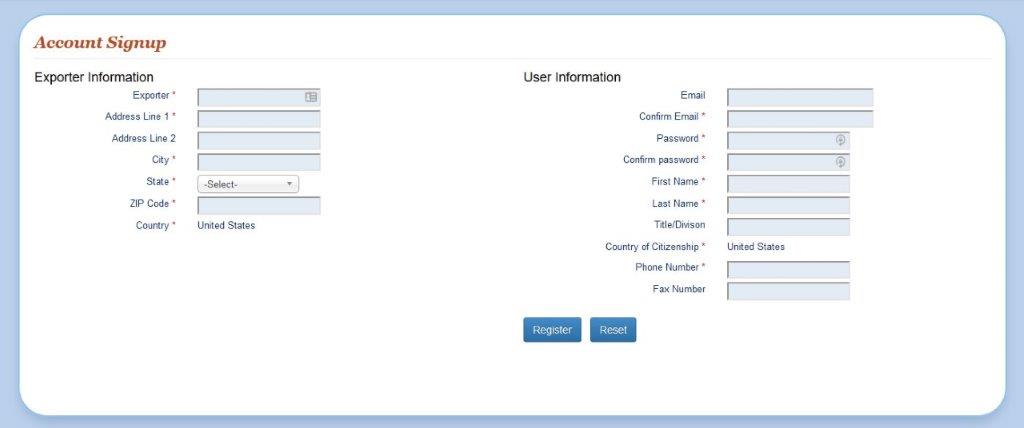
Figure 1 - Account Creation in e810
The data required in Figure 1 fulfills the requirements described in §§ 810.11(a)(1), 810.12(a)(1), and 810.12(c)(1). This form cannot handle the intricacies of corporate control, which would be required to be submitted as an attached file to any actual submittals. There are 11 text fields to be filled out with information readily available to any exporter in this industry. And One drop down selection to establish the state of residence of the export. Once this is completed within e810 it would only have to be addressed if information changes.
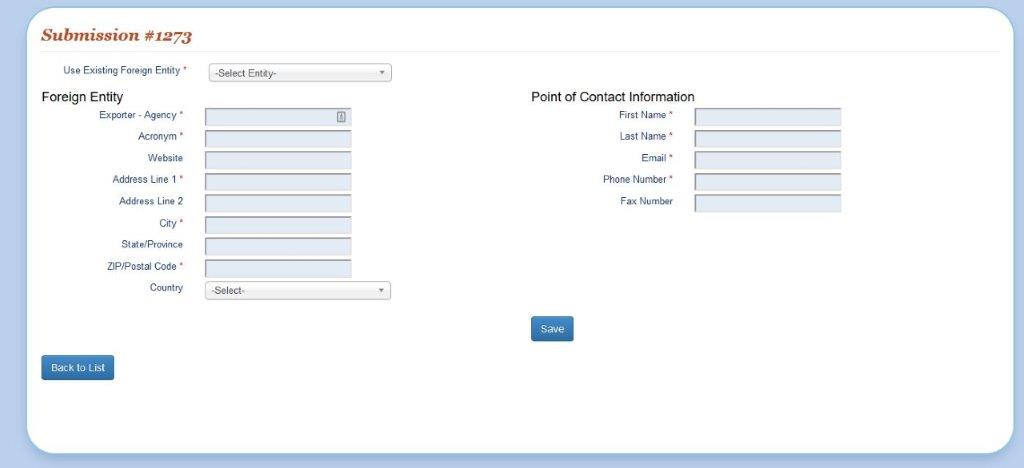
Figure 2 - Foreign entity in e810
The data required in Figure 2 on the left side fulfills the requirements described in §§810.11(a)(2), 810.12(a)(2), and 810.12(c)(2). The additional required information on the right is asked only for specific authorizations and is not explicitly within the rule. This information is to provide other government agencies information to allow the request processing to be done more quickly.
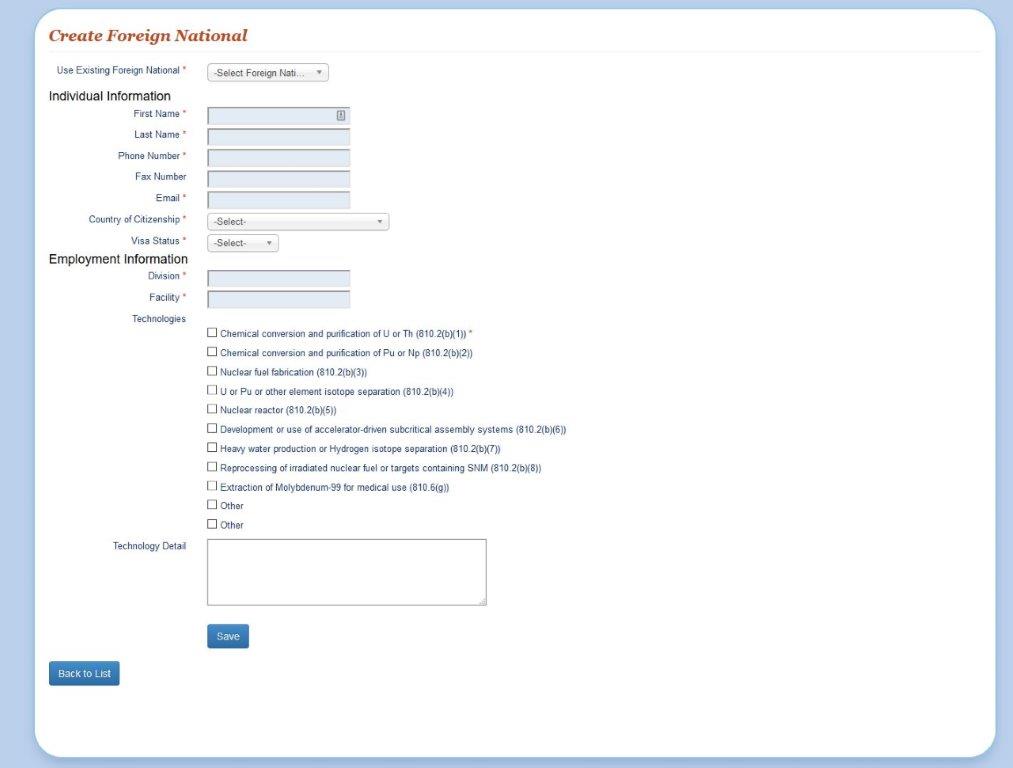
Figure 3 - Foreign National in e810
The data required in Figure 3 fulfills the requirements described in §810.11(b)(1), and partially fulfills the requirements in §810.11(b)(4). The additional information required in §810.11(b) is too complex for a simple form and is handle via document attachment in e810.
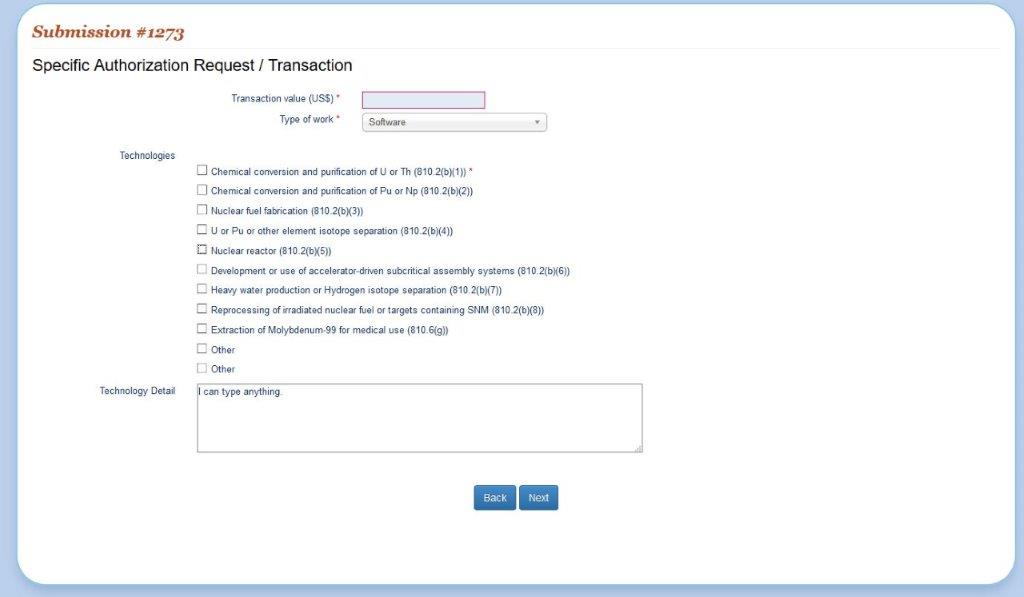
Figure 4 - Transaction information in e810
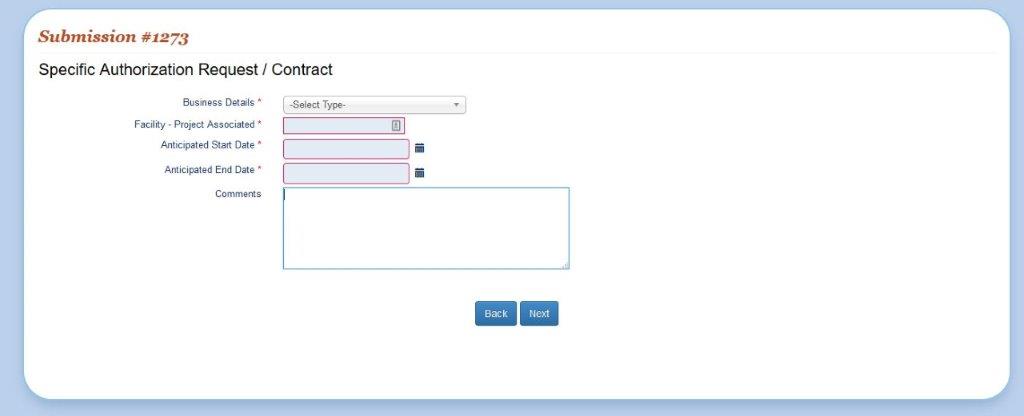
Figure 5 - Contract information in e810
The information requested in Figure 3 and Figure 4 fulfill the requirements in §810.11(a)(3). The checkbox list of technology is directly from relevant sections of the rule and simplify the exporter application by clarifying what specific area of the regulation they believe applies. Where possible, suggested dropdown lists limit free form typing and create more consistency. However, the exporter is always allowed an “other” option with freeform text to explain.
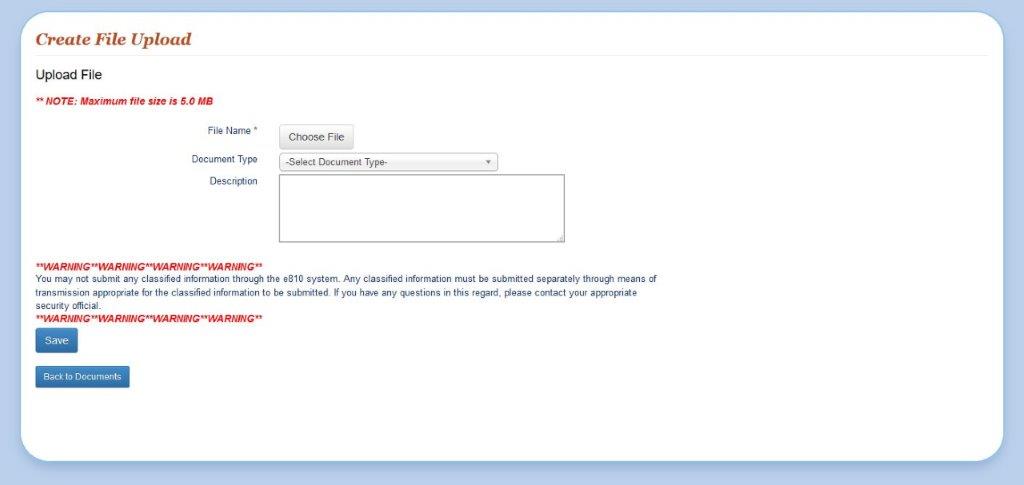
Figure 6 - File upload in e810
To allow the users flexibility in providing the more complex information needed to process Part 810 submittals, free form documents can be attached either via e-mail or within the e810 system. Figure 6 depicts the upload screen.
1 The % of total by fiscal year is calculated as total submission to e810 divided by total number of submissions in a fiscal year from Table 2,
2 Mean submissions per exporter are calculated as the number of submissions per year divided by the number of unique exporters within that year.
3 Total Mean Submissions per exporter is calculated as Total submissions divided by total number of unique exporters.
4 Annual average number of submissions is calculated by dividing the total by 3.6, which represents the number of fiscal years in the table (accounting for the partial year in 2015).
5 The annual average of unique exporters is calculated by summing the number of unique submitters per fiscal year and dividing by 3.6. This accounts for the partial fiscal year and the duplication that occurs each year in the most reasonable fashion.
6 The annual average mean submissions per exporter is calculated by summing the mean submission per exporter by FY and dividing by 4. This creates a reasonable mean as the partial year in FY 2015 is accounted in the lower total submissions and the lower number of unique exporters.
7 Includes Working Capital Fund, travel, training, awards, and information technology services costs.
8 The rate was chosen as representative of the government rate for contractors performing these software development and maintenance functions.
| File Type | application/vnd.openxmlformats-officedocument.wordprocessingml.document |
| Author | ParkerL |
| File Modified | 0000-00-00 |
| File Created | 2021-01-20 |
© 2025 OMB.report | Privacy Policy